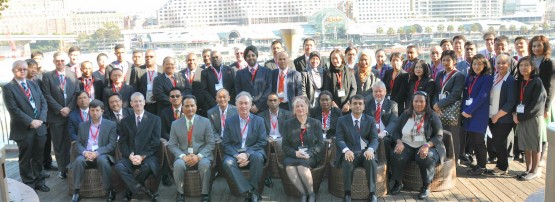
At the end of July, APNIC was given an opportunity to present its IPv6 message to a joint training exercise hosted by the International Telecommunications Union and the Australian Communications and Media Authority, the Australian regulator.
It turned out be a great opportunity to learn and think about the issues these organizations face.
The International Training Program (ITP), “Convergent Regulation Through First Principles Thinking” ran for three days immediately following an ITU Regulator’s Roundtable, a two day agenda. Both were held in Sydney, Australia.
The training attracted 56 participants from 26 countries, including a number of head regulators who had also been there for the roundtable.
The program described in detail how the ACMA is undergoing a transformation based on what it described as a focus on ‘First Principles’. A number of excellent case studies from Bangladesh, Pakistan, New Zealand, Malaysia, India rounded out the agenda.
Throughout the Asia Pacific these various communications regulators sit as a major interface between the dictates of Government and legislation on one side, and the operators and service providers on the other. Regulators’ reach is usually so broad as to include consumer rights, consumer protection, radio spectrum management, competition, however they also find themselves as a key intersection between governments, vendors, users, and service providers on issues such as the push toward universal access to broadband, equipment compliance and more.
Like the ACMA, the APNIC policy framework is based on first principles, in a manner of speaking. The document Policy environment for Internet number resource distribution in the Asia Pacific outlines the core principles of number resource policy in the region.
APNIC Policy lists among its goals, concepts like uniqueness, aggregation, conservation, and registration. This key policy document also highlights environmental factors that should be taken into consideration when forming policy. Factors such as; collective responsibility, impartiality, even Internet growth rates and the idea of minimum allocation.
In addressing policy, two goals—aggregation and conservation— are historically taken to be fundamentally at odds: To address this, the policy states (section 5.1.10. Minimum practical delegation) “because the goals of aggregation and conservation conflict, it is necessary to apply a minimum practical size for address space delegation. This minimum size may be reviewed from time to time, as technologies and administrative conditions evolve.”
This conflict between aggregation and conservation is so important that the original authors of the IPv6 policy made specific mention to how the conflict should be resolved: “In IPv6 address policy, the goal of aggregation is considered to be the most important.” That is to say, since the IPv6 address space is so large, conservation should take a backseat to encourage aggregation in order to control the potentially damaging growth of the routing table.
| IPv4 | IPv6 |
|---|---|
| Deployed 1981 | Deployed 1999 |
| 32-bit address format 192.149.252.76 | 128-bit address format 2001:DB8:0234:AB00:0123:4567:8901:ABCD |
| Address space232 = 4,294,967,296 | Address space 2128 340,282,366,920,938,463,463,374,607,431,768,211,456 |
More than 20 contributors to the original APNIC IPv6 policy are acknowledged at Section 8 in the document, which was first published in 2002. The policy as it stands today still states: “This policy is considered to be an interim policy. It will be reviewed in the future, subject to greater experience in the administration of IPv6.”
It certainly has been reviewed. The current IPv6 address allocation and assignment policy is now in its 12th version, meaning the policy has evolved and changed on average once a year since its original publication.
This demonstrates a certain dynamism and responsiveness that is a credit to the collaborative, consensus-based Policy Development Process the APNIC technical community has fostered and supported over these many years. Yet even that process is open to evolution and development, but more on that soon.
The views expressed by the authors of this blog are their own and do not necessarily reflect the views of APNIC. Please note a Code of Conduct applies to this blog.

This paragraph gives clear idea designed for thhe new viewers of blogging, that genuinely how to do blogging.